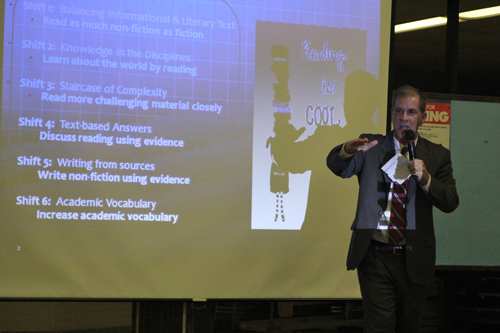How Common Core is being implemented in Riverhead schools

Riverhead School District Superintendent Nancy Carney wants the public to know where the true frustration lies with Common Core.
During the school board’s regular meeting Tuesday night, Ms. Carney said she believes there’s a lot of confusion about the Common Core Standards Initiative since New York adopted it, because several different developments occurred simultaneously when the new curriculum was rolled out, including a state-mandated annual professional performance review plans, known as APPR.
Under the state’s mandate, teacher evaluations are tied to new students assessments based on the Common Core. The initiative primarily requires instructors to teach more non-fiction and more rigorous math to students at a younger age and is a set of national standards designed to raise the bar for classroom instruction.
It’s also designed to help prepare students for college and careers upon graduating high school.
Ms. Carney described the Common Core curriculum itself as “good” and “worthwhile.”
“Our stress and anxiety is from the state’s implementation of putting this into place before we can even unveil our teaching of the Common Core and putting high-stakes testing in place along with tying it to teacher evaluations to something that hasn’t been properly implemented yet,” she said.
The state Department of Education has been heavily criticized by school officials across New York for pushing the new mandates before districts were ready for them. Ms. Carney said she believes the state should set aside new student assessments and the APPR plan until Common Core is properly implemented inside the classroom.
“Public education is at a crossroads,” Ms. Carney said. “We need to be sure its serving everybody and kept under local control.”
She said Riverhead is taking a slow approach toward the new curriculum and wanted the public to know that although the state has designed domains (kindergarten through second grade) and modules (grades 3 through 8) to help teachers achieve the Common Core’s college and career ready goals with students, those lesson plans aren’t mandated.
“Many of the things we’re already doing is helping to meet those standards,” she said. “But we are looking at modules to make sure we are exposing our kids to the skills they will need to be successful.”
When parents express concern about students falling behind as tougher programs are implemented, Ms. Carney said teachers are creating “individual differentiated instruction” as each student’s learning ability is identified.
To make sure students don’t fall behind as tougher programs are implemented, the district is offering new types of support for teachers and students. For example, the district’s Response To Intervention program, known as RTI, provides students with one-on-one instruction.
Tuesday night’s meeting marked the district’s first Common Core presentation of a series planned for upcoming school board meetings.
Riley Avenue Elementary School principal David Enos and Roanoke Avenue Elementary School principal Thomas Payton gave a joint presentation about Common Core practices within English Language Arts and math in grades kindergarten through second grade.
Mr. Enos talked about how ELA is changing under Common Core, including how elementary students are increasing their vocabularies by reading more non-fiction, learning how to attribute information in their writing and how to read closely.
“They’re like detectives looking for evidence,” he said. “Students are learning about the world by reading.”
Mr. Enos said the domains Riverhead has chosen so far — “Learning the Five Senses” for kindergarten; “Animals and Habit” for first grade; and “Cycles in Nature” for second grade — will be implemented during science and social studies class times.
As for math, Mr. Payton said there’s more focus on teaching students math concepts and integrating them within other core subjects.
“Math isn’t just done during math time anymore,” he said. “Students are practicing math concepts with an intensity that focus application in relevant situations.”







